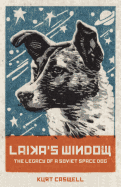
On November 3, 1957, a small dog named Laika was launched into space as part of the Soviet Union's Sputnik 2 mission. This 13-pound mutt, collected from the streets of Moscow and given rigorous training, became the first living thing to orbit the Earth. Laika was also doomed to die. In the rush to mark 40 years since the Bolshevik Revolution, and under pressure from the competing United States, Soviet scientists did not have time to develop a method of bringing Laika back. She died in space, having beaten Yuri Gagarin to his famous milestone. Despite the technical achievements displayed by the launch of Sputnik 2, world opinion turned against the Soviets for sending a dog to her death.
In Laika's Window: The Legacy of a Soviet Space Dog, professor Kurt Caswell (In the Sun's House; Getting to Grey Owl) takes a nuanced, philosophical look at Laika's life and death. Moreover, he considers the Soviet space dog program in the context of animal aerospace tests around the world (including U.S. experiments, which involved the use of electric shocks to make space-borne chimps pull levers). For all the understandable ethical problems with Laika's fate, Caswell finds great meaning in her sacrifice as a landmark in space exploration and in human-dog relations. Like the domestication of canines so many thousands of years ago amid the move to agriculture, mankind's oldest friend joined our next giant leap of civilization. Laika's Window is a beautiful, humane examination of what many would consider an inhumane act. --Tobias Mutter, freelance reviewer

